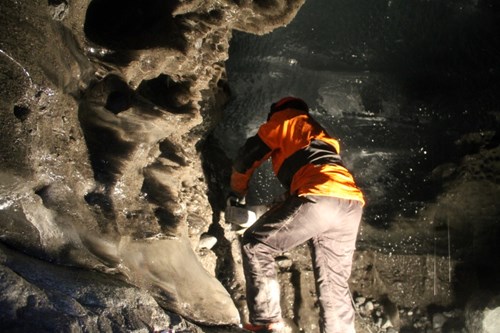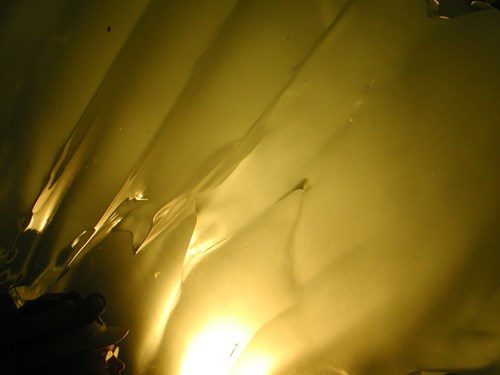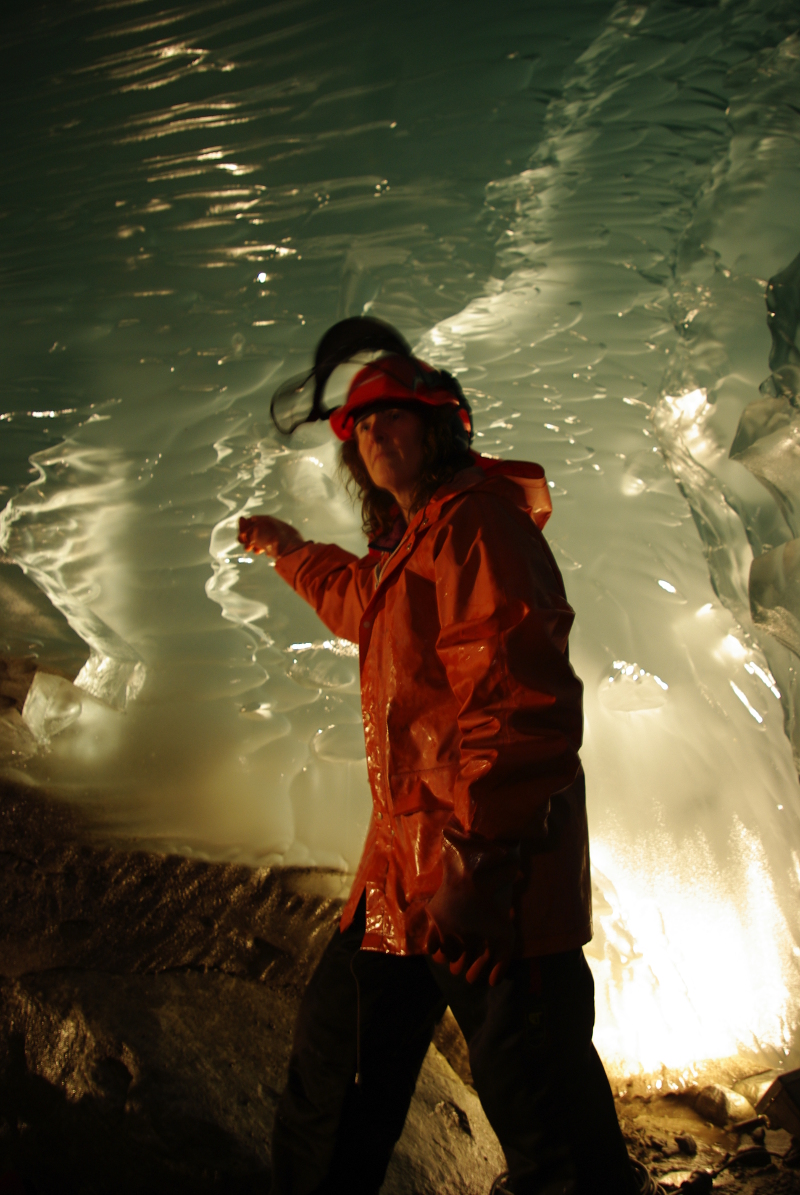Svartisen subglacial observatory
Svartisen Subglacial Laboratory is situated under 200 m of ice in northern Norway. The laboratory provides a unique opportunity for direct access to the bed of a temperate glacier for the purposes of measuring sub-glacial parameters and performing experiments on the ice.
NEW! Subglacial and other data from the laboratory are available here to download.
View fact sheet (norwegian)
View map showing location of Engabreen
Background
A subglacial intake was established beneath Engabreen, one of the valley glaciers draining western Svartisen, in an extensive tunnel network constructed as part of a hydropower development. Permanent tunnels were made through the rock underneath the glacier and lead to access points that open directly at the ice-bed interface.

Sampling basal sediment rich glacier ice in the ice cave using a chain-saw. Photo Miriam Jackson.
At one access point, it is possible to use hot water drilling to melt out ice tunnels in order to gain access to the glacier bed. It is then possible to sample ice that is unaffected by atmospheric processes, to be able to take much larger samples than is possible using boreholes and to leave experiments in place from one year to the next, easily gaining access to them again when necessary.
Video footage from the Subglacial Laboratory
BBC visits glaciologist Dr. Miriam Jackson at the Subglacial Laboratory.
A variety of projects have been completed in the laboratory by researchers from several different institutions. Load cells have been installed beneath the ice and the anti-correlation between basal pressure and discharge has been examined, as well as the relation between load cell pressure and other parameters. An instrumented obstacle was installed at the bed surface and sliding speed, temperatures and stresses on the obstacle were measured. Using these data in a 3D finite element model, it was possible to determine the viscosity parameter in the flow law, which was smaller than published values for clean ice.
Chemical and isotopic (d18O and dD) analysis of a two metre long basal ice core was performed to investigate the mechanisms by which different ice facies have been formed. These and other studies examining the basal stratigraphy of the ice suggest there is considerable water movement therein. Other projects include examining the fabric of the basal ice, tracing experiments to study the subglacial hydrology and examining the basal motion of glaciers over hard beds and soft beds.

Glacier ice in the melted out ice cave. Photo: Miriam Jackson
NEW! Subglacial pressure data and other related data are available to download.
A data package of basal pressure data from the laboratory and other related meteorological and hydrological data from the Svartisen are are available for download. Basic R-codes for preliminary analysis and presentaiton are also included in the data package. The data package can be downloaded as a zipped file here
Note that the download begins automatically when you click on the link. The files were packaged with "7zip" and must be unzipped before use. The data are available "as is". There can be errors and gaps and NVE gives no guarantee for the quality of the data or that it can give misleasding information. Take special consideration of at the R-codes given are more as a starting point and may need further work to perform satisfactorily.
When you use the data please refer and give credit to NVE: https://www.nve.no/brelaboratoriet,
If you have questions send an e-mail to mja [at] nve.no or bre [at] nve.no.
Facilities and equipment in the Subglacial Laboratory
The Svartisen Subglacial Laboratory includes the following facilities available for researchers:
-
Fully-equipped living quarters with beds for up to 8 researchers in four bedrooms, kitchen with cooking facilities, dining/living area, bathroom and shower.
-
Three laboratory rooms, freezer and workshop;
-
Hot-water system for melting subglacial tunnels;
-
Electronics supplies, extensive tool inventory and heavy equipment;
-
External telephone system.

Engabreen
Contact information

